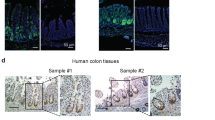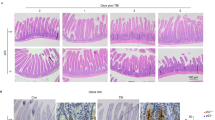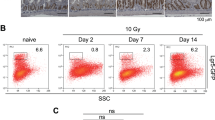Abstract
The radiosensitivity of proliferating crypt epithelial cells makes the gut a major limiting factor in the use of radiotherapy for treatment of abdominal cancers. As post-mitotic epithelial cells migrate from mouse small intestinal crypts to the base of adjacent villi, they rapidly lose their ability to undergo apoptosis in response to ionizing irradiation (IR). To determine whether this radioresistance reflects withdrawal from the cell cycle, we used a lineage-specific promoter to direct expression of wild type Simian virus 40 T antigen (SV40 TAgWt) to villus, but not crypt, enterocytes in FVB/N transgenic mice. SV40 TAgWt induced, pRB-dependent, re-entry into the cell cycle is not associated with the acquisition of IR-stimulated apoptosis 4 h or 24 h after 6 Gy or 12 Gy of γ-irradiation. Co-expression of SV40 TAgWt and K-rasVal12 produces dysplasia in cycling villus enterocytes but no shift towards apoptotic responsiveness to IR. These findings suggest that the radioresistance of villus enterocytes is not simply due to their cell cycle arrest and may be a reflection of their microenvironment. Remarkably, re-entry of villus enterocytes to the cell cycle increases the radiosensitivity of the crypt epithelium without changing Bcl-2, Bcl-xL, Bak, or Bax expression. This effect is only manifest after IR and, based upon results obtained with mutant SV40 TAgs, depends upon reaching a critical level of proliferation in villus enterocytes. Like the normal crypt response to IR, the villus-derived enhancement of IR-stimulated crypt apoptosis is associated with an induction of p53 and Raf-1, and is dependent upon p53. Unlike the normal crypt response to IR, the p53 induction involves cells distributed throughout the crypt and the apoptotic response is not confined to the lower half of the crypt. These results indicate that signals initiated by cycling enterocytes can be transmitted to the crypt epithelium to induce p53 and influence their IR-induced apoptosis. Understanding the underlying signaling pathways may provide clues about how to modify a normal crypt's radiosensitivity for therapeutic benefit.
This is a preview of subscription content, access via your institution
Access options
Subscribe to this journal
Receive 50 print issues and online access
$259.00 per year
only $5.18 per issue
Buy this article
- Purchase on Springer Link
- Instant access to full article PDF
Prices may be subject to local taxes which are calculated during checkout
Similar content being viewed by others
Author information
Authors and Affiliations
Rights and permissions
About this article
Cite this article
Coopersmith, C., Gordon, J. γ-Ray-induced apoptosis in transgenic mice with proliferative abnormalities in their intestinal epithelium: re-entry of villus enterocytes into the cell cycle does not affect their radioresistance but enhances the radiosensitivity of the crypt by inducing p53. Oncogene 15, 131–141 (1997). https://doi.org/10.1038/sj.onc.1201176
Received:
Revised:
Accepted:
Issue Date:
DOI: https://doi.org/10.1038/sj.onc.1201176
Keywords
This article is cited by
-
Both the anti- and pro-apoptotic functions of villin regulate cell turnover and intestinal homeostasis
Scientific Reports (2016)
-
The Protective Role of Interleukin-11 Against Neutron Radiation Injury in Mouse Intestines via MEK/ERK and PI3K/Akt Dependent Pathways
Digestive Diseases and Sciences (2014)
-
E2f1–3 switch from activators in progenitor cells to repressors in differentiating cells
Nature (2009)



